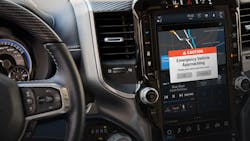New Technology for Virtual 9-1-1, Roadway and Firefighter Safety
Rapid advances in technology are a way of life, and their impact is certainly felt in the fire service. Whether it’s an update to an existing application or a completely new way of doing business, changes that make our jobs easier or safer are worth exploring. Let’s begin the year with a look at recent developments across the board.
Taking 9-1-1 remote
From the government side of the house come exercises designed to enhance the capacity of dispatch centers. Outreaches through Next Generation 9-1-1 and FirstNet, among others, are expanding both interoperability and capacity of these facilities. At a recent meeting of the Maryland Association of Counties, elected and appointed leaders were provided a demonstration of how Maryland’s 24 Public Safety Answering Points (PSAPs) are now equipped to answer 9-1-1 calls from an alternate location, including other government facilities or even a call taker’s residence. This new capability provides added flexibility if a PSAP is quarantined, has reduced on-duty staffing or facility limitations.
Steve Hurlock, communications division chief for Caroline County, MD, discussed his agency’s participation along with five others in this exercise, and the benefits that this technology brings. Having served as chief, and currently as assistant chief for Church Hill Volunteer Fire Company, Hurlock has 33 years of fire service experience and is acutely aware of the need for uninterrupted communications.
“We processed calls using the same system that we use in our center, except using laptops. The 9-1-1 Board was gracious enough to provide them to every center in the state. We had previously purchased two of these units and have used them in actual incidents where they worked flawlessly. It allowed a deputy to answer calls about the event directly in the command trailer, which removed this call load from the dispatchers.” He also went on to explain that having a dispatch presence in the field also helps reduce unnecessary communications by having answers and resources in the field, and continued, “The way that technology is evolving we need to grasp it as best as we can. The technology today compared to even 10 years ago is completely different.”
There are many benefits to “virtual 9-1-1” and also hurdles to cross. For more background, check out Fire Dispatch: Virtual 9-1-1—The Time Is Now. With the dual pandemics of COVID-19 and telecommunicator shortages likely to continue for the foreseeable future, look for more innovative solutions aimed at maximizing resources to appear this year.
Roadway safety
An increasing number of 9-1-1 calls means challenges both in dispatch and the field. Obviously, the greater the number of responses, the greater the danger to first responders. In order to combat this trend, conventional apparatus-mounted warning devices are being augmented with systems that broadcast alerts to nearby vehicles. According to an article published by the National Highway Administration these systems can be very effective. “The Pennsylvania Turnpike Commission has equipped 158 maintenance and service patrol vehicles with the ability to broadcast emergency alerts…According to Pennsylvania Turnpike Commission TIM Coordinator Todd Leiss, crashes involving roadside agency vehicles were reduced from 30 in 2018 to zero in 2020. He attributes much of the credit for that reduction to emergency vehicle alerts.”
According to Brock Aun, director of communications for HAAS Alert, “last year was the deadliest year for first responders on the road on record. The Emergency Responder Safety Institute documented 65 deaths on the road, including 8 fire service professionals. This is in addition to the more than 16,000 apparatus collisions recorded annually according to the NFPA.”
"What this means is that despite move-over laws in every state, bright lights and sirens, and dramatic improvements in consumer vehicle safety, roadway response is more dangerous than ever for fire crews. This is the core problem that we're working to solve through our digital alerting service Safety Cloud.”
Safety Cloud alerts are now being delivered to drivers of Jeep, Dodge, Ram, Chrysler, and Alfa Romeo vehicles, as well as through the popular navigation app Waze. HAAS Alert says that Safety Cloud is now processing nearly 3 million digital alerts daily, in part because many manufacturers have integrated the service on new apparatus for additional fire crew protection.
“Safety Cloud is now a standard safety feature that is preinstalled and included on new apparatus from Pierce, Rosenbauer, Seagrave, E-One, Ferrara, REV, KME, and Marion Body. Over the last year, the number of departments nationwide using Safety Cloud has surpassed 1,000, and the number of alerts we've processed from those departments surpassed 1 billion.”
Among the growing number of users is DC Fire and EMS Department and Lubbock Fire Rescue. More information about the recent Lubbock deployment can be found here.
Monitoring health data
Firefighter safety is, indeed, a personal responsibility and concern, and departments such as Duxbury, MA, have taken this to the individual level. At the beginning of the pandemic, firefighters were issued rings that monitor key vital signs, including temperature. Working in a fashion similar to fitness watches and bracelets, members can access their biometrics through a cell phone app. Data is not shared. In a telephone interview with Firehouse, Chief Kevin Nord explained the rationale behind implementing the program along with their ongoing experiences.
“We started the program about a year and a half ago with the onset of COVID. We were looking for a way to monitor temperatures because that seemed to be the first variant in diagnosis,” Nord said. To this end, early on, cases were discovered in this manner. “It is a voluntary program and 26 of our 28 firefighters opted in, and we’ve had great success with it. I personally wear one.”
“Another benefit is the monitoring of sleep cycles. For those concerned with physical fitness, it also monitors steps and caloric burn rate, and at the end of the week provides a summary of your activity.” Battery life is about one week, and it takes approximately an hour to recharge.
When questioned as to future plans, the chief shared, “We have had 10 firefighters sign up for the next generation of devices that will record additional data. This will help us stay safer and healthier, here.”
One unintended side benefit is that unofficial competitions develop between firefighters and friends and family members who also monitor their signs with other devices. This complements the individual monitoring of sleep cycles and modes and cardiac data. Again, all of this benefits overall health.
According to Chief Nord, “Firefighters are being more mindful of their sleep cycles and their health, and what they are doing during the day. I can only imagine that this helps reduce sick leave, and that I have firefighters coming to work who are ready to go.”
The chief is looking forward to future releases that contain pulse/oximeter data, and in hearing from others who are running similar programs. He may be contacted here. More information on the rings is available through the manufacturer. In the interim, Chief Nord, “Is just trying to give firefighters more information on their day-to-day work and rest cycles, because there is a direct correlation as to how well they can fend off illness and disease.”
About the Author

Barry Furey
BARRY FUREY, who is a Firehouse Contributing Editor, provides consulting and training services in emergency communications. He is the former director of the Raleigh-Wake Emergency Communications Center in North Carolina. During his 50-year public safety career, he has managed 9-1-1 centers and served as a volunteer fire officer in three other states. In 2005, Furey received a life membership in the Association of Public-Safety Communications Officials (APCO) International for his continued work in emergency communications. Furey was inducted into the Firehouse Hall of Fame in 2017.
